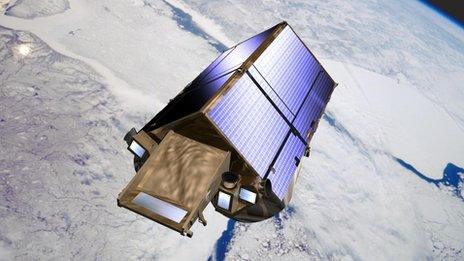Arctic sea ice 'melting faster'
- Published

Esa's Cryosat spacecraft uses radar to measure ice thickness
Arctic sea ice is vanishing much faster than generally expected, according to preliminary data from European Space Agency satellite Cryosat.
UK scientists combined results from Cryosat, which uses radar to measure ice thickness, with data from Nasa's IceSat, which uses lasers.
Their preliminary analysis suggests an annual ice loss of up to 900 cubic km a year from 2004.
Projections of Arctic ice melt vary widely.
But the new results are some 50% higher than projected in most scenarios.
The ice loss is pronounced in areas to the north of Greenland where thickness has fallen from 5-6m a decade ago to around 3m last year.
The analysis was done by Dr Seymour Laxon, reader in climate physics at the Centre for Polar Observation and Modelling.
He said the figures might change slightly when all the data had been analysed but that the broad thrust of the research showed a clear and dramatic thinning of the sea ice.
At the end of last summer 7,000 cubic km of ice remained.
The satellite figures were cross-checked against data from planes over-flying the Arctic and submerged buoys sending sonar signals to measure ice thickness. Dr Laxon said the results were thought to be accurate within 10cm (3.5in).
"We have to be cautious until our data has been properly analysed as part of a climate model, but this does suggest that the Arctic might be ice-free in summer for a day at least by the end of the decade," he told BBC News.
"But the past is not always a guide to the future."
The Arctic is warming much faster than the rest of the planet and the loss of sea ice affects populations.
The light-coloured sea ice bounces back warmth into space. If it disappears, the Arctic Ocean will absorb more heat.
That will cause more warming which will in turn contribute to sea level rise. It may also affect Europe's weather because of the link between sea ice and the jet stream which dominates some of our weather patterns.
There are many uncertainties. Scientists cannot be sure how much of the Arctic warming is natural and how much it is being driven by manmade climate change.
Last month a Nasa news release headlined news of an "unprecedented Greenland Ice Sheet Surface melt". Images showed that in July, 97% of Greenland's ice sheet experienced some degree of melting at the surface in July.
Many readers assumed that manmade climate change was being blamed. But Laura Koenig, a Goddard glaciologist, confirmed in the same news release that melting events of this nature happen naturally on average every 150 years.
"If it continues it will be worrisome," she said.
- Published24 April 2012
- Published20 April 2012